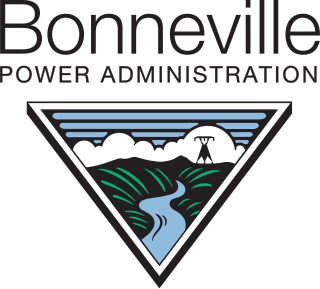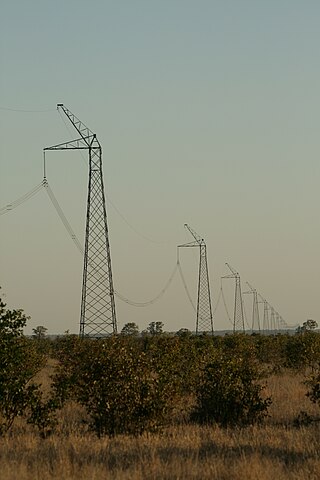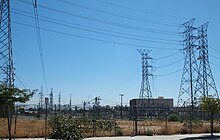
A high-voltage direct current (HVDC) electric power transmission system uses direct current (DC) for electric power transmission, in contrast with the more common alternating current (AC) transmission systems.

The Bonneville Power Administration (BPA) is an American federal agency operating in the Pacific Northwest. BPA was created by an act of Congress in 1937 to market electric power from the Bonneville Dam located on the Columbia River and to construct facilities necessary to transmit that power. Congress has since designated Bonneville to be the marketing agent for power from all of the federally owned hydroelectric projects in the Pacific Northwest. Bonneville is one of four regional Federal power marketing agencies within the U.S. Department of Energy (DOE).

The HVDC Volgograd–Donbass is a 475 kilometres (295 mi) long bipolar ±400 kV high voltage direct current powerline used for transmitting electric power from Volga Hydroelectric Station at Volgograd in Russia to the Donbass in eastern Ukraine and vice versa.
The HVDC Inter-Island link is a 610 km (380 mi) long, 1200 MW high-voltage direct current (HVDC) transmission system connecting the electricity networks of the North Island and South Island of New Zealand together. It is commonly referred to as the Cook Strait cable in the media and in press releases, although the link is much longer than its Cook Strait section. The link is owned and operated by state-owned transmission company Transpower New Zealand.

The Nelson River DC Transmission System, also known as the Manitoba Bipole, is an electric power transmission system of three high voltage, direct current lines in Manitoba, Canada, operated by Manitoba Hydro as part of the Nelson River Hydroelectric Project. It is now recorded on the list of IEEE Milestones in electrical engineering. Several records have been broken by successive phases of the project, including the largest mercury-arc valves, the highest DC transmission voltage and the first use of water-cooled thyristor valves in HVDC.

Cahora-Bassa is a separate bipolar HVDC power transmission line between the Cahora Bassa Hydroelectric Generation Station at the Cahora Bassa Dam in Mozambique, and Johannesburg, South Africa.

The Inga–Shaba EHVDC Intertie is a 1,700 kilometres (1,100 mi)-long high-voltage direct current overhead electric power transmission line in the Democratic Republic of Congo, linking the Inga hydroelectric complex at the mouth of the Congo River to mineral fields in Shaba (Katanga). It was primarily constructed by Morrison-Knudsen International, an American engineering company, with the converter equipment supplied by ASEA. Construction was completed in 1982 and it cost US$900 million. The scheme was, for many years, the longest HVDC line in the world.
The HVDC Itaipu is a High-voltage direct current overhead line transmission system in Brazil from the Itaipu hydroelectric power plant to the region of São Paulo. The project consists of two ±600 kV bipoles, each with a rated power of 3150 MW, which transmit power generated at 50 Hz from the Paraguay side of the Itaipu Dam to the Ibiúna converter station near São Roque, São Paulo. The system was put in service in several steps between 1984 and 1987, and remains among the most important HVDC installations in the world.

Path 27, also called the Intermountain or the Southern Transmission System (STS), is a high-voltage direct current (HVDC) electrical transmission line running from the coal-fired Intermountain Power Plant near Delta, Utah, to the Adelanto Converter Station at Adelanto, California, in the Southwestern United States. It was installed by Asea, a company based in Sweden, and commercialized in July 1986. The system is designed to carry power generated at the power plant in Utah to areas throughout Southern California. It is owned and operated by the Intermountain Power Agency, a cooperative consisting of six Los Angeles-area cities, the largest member being the Los Angeles Department of Water and Power (LADWP), and 29 smaller Utah municipalities.
The Eel River Converter Station is a high-voltage direct current (HVDC) converter station in Eel River Crossing, New Brunswick, Canada; it is the first operative HVDC station in the world equipped with thyristors.
The HVDC Rihand–Delhi is a HVDC connection between Rihand and Dadri in India, put into service in 1990. It connects the 3,000 MW coal-based Rihand Thermal Power Station in Uttar Pradesh to the northern region of India. The project has an 814 kilometres (506 mi) long bipolar overhead line. The transmission voltage is 500 kV and the maximum transmission power is 1,500 megawatts. The project was built by ABB.
The Sylmar Converter Station is the southern converter station of the Pacific DC Intertie, an electric power transmission line which transmits electricity from the Celilo Converter Station outside The Dalles, Oregon to Sylmar, a neighborhood in the northeastern San Fernando Valley region of Los Angeles, California. The station converts the 500 kV direct current coming from the northern converter station Celilo to alternating current at 60 Hz and 230 kV synchronized with the Los Angeles power grid. The station capacity is 3,100 megawatts. It is jointly owned by two electric utility providers, Southern California Edison and Los Angeles Department of Water and Power.

The Celilo Converter Station, built in 1970 and owned and operated by the Bonneville Power Administration, is the northern terminus of the Pacific DC Intertie, near The Dalles, Oregon, in the United States.

GKK Etzenricht, an abbreviation of Gleichstromkurzkupplung Etzenricht, meaning Etzenricht HVDC-back-to-back station, was an HVDC back-to-back facility near Etzenricht in the district of Neustadt an der Waldnaab in Bavaria, Germany. It was built on the site of the Etzenricht substation, a 380 kV/220 kV/110 kV-substation, which went into service in 1970 and expanded afterwards several times. The facility was used between 1993 and 1995 for the exchange of power between Germany and the Czech Republic, operated by Bayernwerk AG.
The Levis De-Icer is a High voltage direct current (HVDC) system, aimed at de-icing multiple AC power lines in Quebec, Canada. It is the only HVDC system not used for power transmission.
The Vizag back-to-back HVDC station, or Visakhapatnam back-to-back HVDC station, is a back-to-back HVDC connection between the eastern and southern regions in India, located close to the city of Visakhapatnam, and owned by Power Grid Corporation of India.
An HVDC converter converts electric power from high voltage alternating current (AC) to high-voltage direct current (HVDC), or vice versa. HVDC is used as an alternative to AC for transmitting electrical energy over long distances or between AC power systems of different frequencies. HVDC converters capable of converting up to two gigawatts (GW) and with voltage ratings of up to 900 kilovolts (kV) have been built, and even higher ratings are technically feasible. A complete converter station may contain several such converters in series and/or parallel to achieve total system DC voltage ratings of up to 1,100 kV.
The Rio Madeira HVDC system is a high-voltage direct current transmission system in Brazil, built to export power from new hydro power plants on the Madeira River in the Amazon Basin to the major load centres of southeastern Brazil. The system consists of two converter stations at Porto Velho in the state of Rondônia and Araraquara in São Paulo state, interconnected by two bipolar ±600 kV DC transmission lines with a capacity of 3,150 megawatts (4,220,000 hp) each. In addition to the converters for the two bipoles, the Porto Velho converter station also includes two 400 MW back-to-back converters to supply power to the local 230 kV AC system. Hence the total export capacity of the Porto Velho station is 7100 MW: 6300 MW from the two bipoles and 800 MW from the two back-to-back converters. When Bipole 1 commenced commercial operation in 2014, Rio Madeira became the world’s longest HVDC line, surpassing the Xiangjiaba–Shanghai system in China. According to the energy research organisation Empresa de Pesquisa Energética (EPE), the length of the line is 2,375 kilometres (1,476 mi).
The Xiangjiaba–Shanghai HVDC system is a ±800 kV, 6400 MW high-voltage direct current transmission system in China. The system was built to export hydro power from Xiangjiaba Dam in Sichuan province, to the major city of Shanghai. Built and owned by State Grid Corporation of China (SGCC), the system became the world’s largest-capacity HVDC system when it was completed in July 2010, although it has already been overtaken by the 7200 MW Jinping–Sunan HVDC scheme which was put into operation in December 2012. It also narrowly missed becoming the world’s first 800 kV HVDC line, with the first pole of the Yunnan–Guangdong project having been put into service 6 months earlier. It was also the world’s longest HVDC line when completed, although that record is also expected to be overtaken early in 2013 with the completion of the first bipole of the Rio Madeira project in Brazil.
Adelanto Converter Station in Adelanto, California, is the southern terminus of the 2,400 MW Path 27 Utah–California high voltage DC power (HVDC) transmission line. The station contains redundant thyristor-based HVDC converters rated for 1,200 MW continuous or 1,600 MW short term overload. The 300-acre (120 ha) station was completed in July, 1986 at a cost of US$131 million. The northern terminus of Path 27 is fossil fueled Intermountain Power Plant in Utah.















